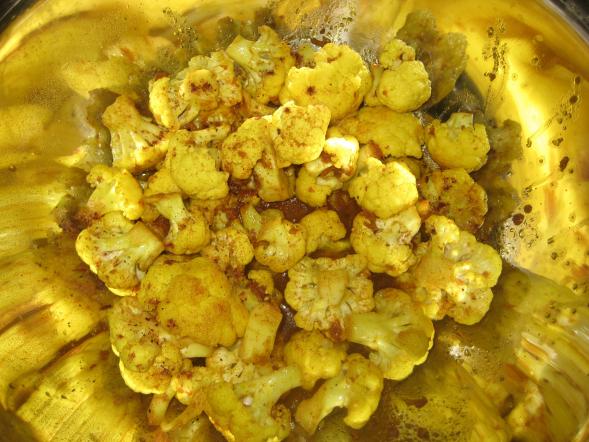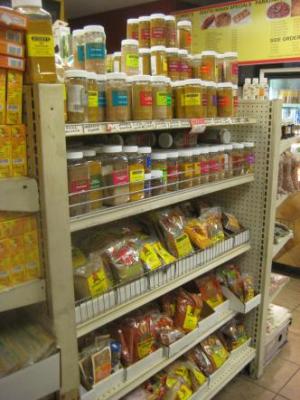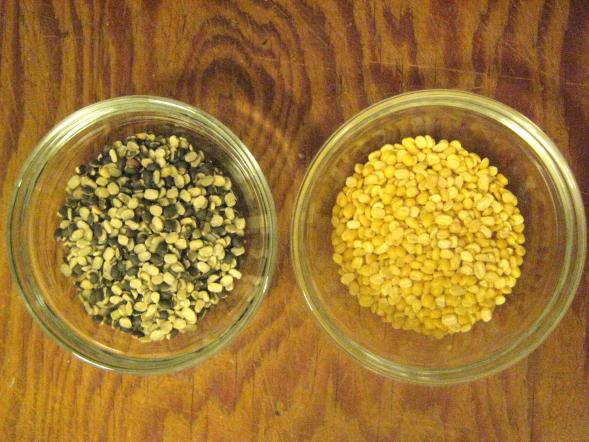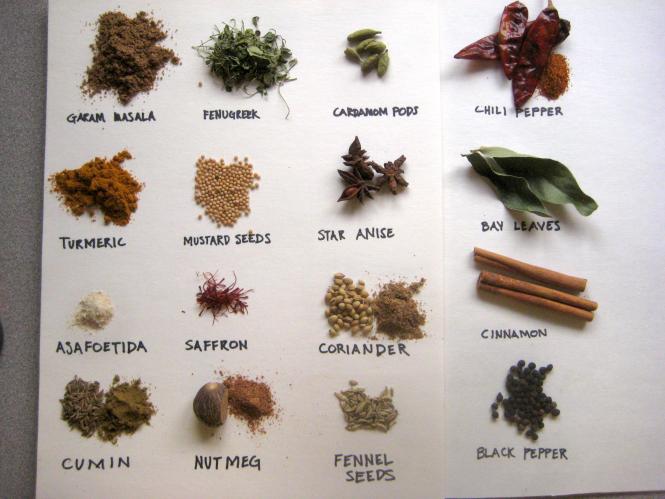I have loved Indian food ever since I was a kid, when, as a picky eater on a family vacation to England, I subsisted almost entirely on a diet of CTM – chicken tikka masala, the national dish of post-colonial Britain. This Anglo-Indian hybrid of grilled marinated chicken in a spiced tomato cream sauce is hardly authentic Indian food – you won’t find it in most self-respecting Indian cookbooks, and in fact today I live up the street from any Indian restaurant that goes by the defiantly anti-tikka (and painfully awkward) name of “No Tomatoes!” But for me, CTM was a gateway drug that led me down the delicious and aromatic path to kormas, dosas, puris, saags, biryanis, and heck, even the odd kofteh.
Yet despite years of eating and enjoying Indian food, I’ve always been too intimidated to cook the stuff myself. Don’t get me wrong, there have been nights where I’ve dreamt of curry for dinner and flipped longingly through Indian recipes, only to run into enough unfamiliar ingredients that my natural laziness gets the better of me, and before I know what happened I’m sitting in front of yet another plate of spaghetti aglio-olio.
 Dry Spiced Cauliflower
Dry Spiced Cauliflower
Finally this summer I decided to sit down and figure out, in a systematic way, what I would need if I was going to learn to cook Indian food. The result of this experiment is a loaded spice cabinet, a fridge full of delicious leftovers and a kitchen wall splattered with bright yellow turmeric. Plus there’s this blog-post. I don’t claim to be an expert, but at least I can let you in on my experience, tell you how I researched the essentials, give you a list of tools and ingredients, and finally, if you’re feeling ambitious, I’ve even got a recipe to make your own garam masala spice blend. Hopefully some nice concrete list-making will convince a few people out there to take the plunge, buy the spices, and discover that it really does not take much to cook great Indian food at home.
First, let’s talk methodology. Even though I’ve typed “Indian food” a few hundred times already, there is really no such thing. India is a huge country, and each region has its own cuisine: the majority of dishes we see in Indian restaurants here in the US of A, for example, are from Delhi and Punjab, in the north and northwest areas of the country. The food can be very different in the south and east of the country, and while there are definitely some common ingredients, there’s no way a novice like me could cover the whole subcontinent. So over the past couple weeks I’ve cooked up a storm from three different general-survey type cookbooks: India: The Cookbook by Pushpesh Pant, A Taste of India by Madhur Jaffrey, and Julie Sahni’s Introduction to Indian Cooking by, believe it or not, Julie Sahni (plus I made a slight detour to the Food & Wine and Serious Eats to learn more about chicken tikka masala). Of these sources I’d say A Taste of India is the best introduction, while India: The Cookbook is beautiful, gigantically comprehensive, but a little confusing and vague, so probably best to crack open after you’ve had some practice.
So far I’ve made chicken korma with saffron, ginger-heavy Moghali spinach, aromatic rice pilaf, the classic Punjabi chickpea dish chana masala, South Indian fish curry, stir-fried cabbage with turmeric and chilies, dry kikhari with basmati rice and moong dal, chicken tikka masala, spinach and moong dal soup, mint rice, and dry spiced cauliflower. Holy cow, I am stuffed.
 In the moments of clarity
between blissful food comas, I spent a couple afternoons browsing the aisles of
my local market/restaurant India Sweets and Spices.
I started making a list of the ingredients I was buying to complete all these
recipes. Then I had the boys down at the lab run the text of all the recipes
through one of the internet’s many free word-cloud
generators in order to visually get an
idea of what who the recurring players were. At the same time I asked for
advice and for lists of vital ingredients from friends and coworkers who grew
up cooking Indian food. Then I ran all the advice and data through the proverbial
spice-grinder, and came up with the following inventory of tools and
ingredients.
In the moments of clarity
between blissful food comas, I spent a couple afternoons browsing the aisles of
my local market/restaurant India Sweets and Spices.
I started making a list of the ingredients I was buying to complete all these
recipes. Then I had the boys down at the lab run the text of all the recipes
through one of the internet’s many free word-cloud
generators in order to visually get an
idea of what who the recurring players were. At the same time I asked for
advice and for lists of vital ingredients from friends and coworkers who grew
up cooking Indian food. Then I ran all the advice and data through the proverbial
spice-grinder, and came up with the following inventory of tools and
ingredients.
Tools:
On the most basic level, all you really need to cook Indian foods are some large pots for cooking rice, peas, and grains, as well as soups or stews, and a large frying pan or wok for sautéing. But if you have them, the following toys will come in handy:
- Blender/Cuisinart: because recipes sometimes ask for spices to be added as a paste blended with water and/or ginger, garlic, onions, etc.
- Pressure cooker: I don’t have one, but my friend swears by it as a way to dramatically speed up lentil, split pea, and bean dishes.
- Mortar and pestle: for breaking up pods, seeds, and other whole spices.
- Spice grinder: because that mortar and pestle is hard work, and it still can’t break down some harder ingredients.
Ingredients:
 the spice aisleI was pleasantly surprised
to find out how quick and easy a lot of Indian recipes were, but I also found
that even fast recipes involved more spices than I was used to – five or six,
or sometimes a dozen or more different seasonings. All those spices are
absolutely worth it for the interplay of flavors, but they can make for a
daunting shopping list. With that in mind, I’ve tried to break things down into
three tiers of ingredients, ranked by how easy they are to find and by how
frequently you’ll be using them.
the spice aisleI was pleasantly surprised
to find out how quick and easy a lot of Indian recipes were, but I also found
that even fast recipes involved more spices than I was used to – five or six,
or sometimes a dozen or more different seasonings. All those spices are
absolutely worth it for the interplay of flavors, but they can make for a
daunting shopping list. With that in mind, I’ve tried to break things down into
three tiers of ingredients, ranked by how easy they are to find and by how
frequently you’ll be using them.
1. The Basic Package
These ingredients are easy to buy at your local supermarket, a lot of them may be in your kitchen already, most are pretty universal and will be useful for many cuisines beyond Indian food, and they will set you up for cooking a lot of simple dishes, like chana masala or Moghali spinach. In fact if you’ve got a really cramped kitchen, there’s a lot you could cook with just the first four items, plus fresh ginger. One way to save money while building your Indian arsenal is to buy your spices from the bulk aisle of your local food co-op or a local Mexican market, where a lot of them can be found for sale cheaply in little plastic sacks; spices cost about half as much when you’re not paying Spice Islands for that classy glass bottle.
Ground Cumin
Ground Coriander
Chili powder / Cayenne pepper / Dried chilies
Turmeric
Salt
Black Pepper
Cinnamon sticks
Nutmeg
Fennel seeds
Cloves
Mustard seeds
Bay leaves
Fresh ginger
Fresh garlic
Fresh Cilantro
Fresh Mint
Basmati rice
2. The Deluxe Package
The next tier up of ingredients may require travelling a little further afield, but you should be able to find them most of them in your local food co-op or in a Whole Foods (or any similar ambitious, foodie-baiting grocery store). The first seven items are spices; the last ones, the dals, are pulses, or types of split beans and peas, and are usually found in the bulk dry goods area alongside the tubs of rices, nuts, lentils, etc.
 Toovar Dal & Moong DalGaram Masala
Toovar Dal & Moong DalGaram Masala
Cardamom pods
Cumin seeds
Coriander seeds
Saffron
Star anise
Poppy seeds
Dried coconut
Dal –
Moong dal, or skinned split mung beans
Masoor dal, or red split lentils
Toovar dal, chana dal and urad dal are various different kinds of split peas
3. The Sharukh Khan Executive Platinum Imperial Super-Deluxe Package:
The highest degree of difficulty: Named for Bollywood’s biggest star, this final group of ingredients will probably require to a trip to an Indian grocery store. In case your town doesn’t have a Little India like the one out here in Artesia, California, or if your kitchen is just so full at this point that the producers of Hoarders are banging on the door, then I’ve tried to suggest easily-sourced substitutes where possible. That said, everyone I spoke with warned me that these are pretty poor substitutes – the replacement refs of Indian cooking, if you will – and in the case of curry leaves or asofoetida is may just be worth leaving the ingredient out entirely rather than scrounging for a replacement. But if you’re willing to take the plunge and track down the following items, they will definitely add an extra richness of flavor and aroma to any recipe that calls for them.
Fenugreek seeds
Curry/kahri leaves – Not at all related to curry powder, so don’t even think of swapping one for the other. Emergency substitute: lime juice and fresh basil.
Asofoetida – Also known as Hing, this white powder has a strong, unpleasant smell out of the jar but it mellows when cooked. Common in vegetarian dishes, it also helps prevent gas (as well as having various other possible medical applications.) Emergency sub: garlic.
Jaggery – Unrefined raw whole cane sugar, often comes in a packed into a hard cylinder shape. Emergency sub: brown sugar.
Amchoor – a citrusy powder made of unripe, dried mango. Substitute: lemon or lime juice.
Tamarind – This comes in many forms but go ahead and buy the concentrated paste, said my coworker, because using tamarind pods to make the paste from scratch is time-consuming and tastes basically the same. Also used in Mexican, Caribbean, African, and Southeast Asian cuisines, so any number of ethnic markets could have this on the shelves.
That is a long list, but it has served me well. Now before I sign off to go finish the last of my leftover CTM, I’ll leave you with one of the unexpected and exciting discoveries from this kitchen adventure: my coworker’s family recipe for garam masala spice mix.
Garam Masala Spice Mixture
There are no quantities in this recipe, which is enough to make an inveterate recipe-hugger like myself throw up his hands and start hyperventilating. But India’s a big country, and if it’s home to a billion people than it’s home to at least a quarter billion different recipes for garam masala, at least one for each family. This one comes from my coworker, who advised that you just have to experiment to find a mixture that tastes good. However I’ve noticed most recipes are heavy on the cumin, so try 3 parts cumin / 2 parts coriander / 1 part everything else as a starting point, then experiment from there.
 Ingredients:
Ingredients:
Cumin seeds
Coriander seeds
Anise/Fennel seeds
Black pepper
Dry ground ginger
Cardamom
Cloves
Cinnamon
Bay leaves
Instructions:
Grind everything to a powder; mix; strain through a sieve; store in a clean, dry, airtight container. There are two ways to go about this:
1. The High-Tech method uses a spice grinder, and mostly whole spices. You can grind whole cumin and coriander seends, whole cinnamon sticks, cloves, cardamom pods, pepper, and peppercorns. The only exception is ginger: use powdered ginger rather than the fresh root, so that the mixture is dry.
2. The Low-Tech method might use a mortar and pestle, but mostly you’ll just buy ground spices. Some of these ingredients don’t grind easily – cinnamon sticks and coriander pods, for example, laugh at mortars and pestles – so use powdered cinnamon, ground coriander and cumin, and grind pepper from a pepper mill. Fennel seeds, cloves, bay leaves, and the seeds inside of cardamom pods are easy to grind by hand. And again, this is a dry spice mixture, so use powdered ginger rather than fresh.
Finally, since garam masala is often sprinkled on dishes after they are cooked, I’d advise straining the mixture through a sieve before you bottle it. Seriously folks, I spent entirely too much time picking cardamom pods and cinnamon shrapnel out of my food these past couple weeks. I’d complain if it all hadn’t tasted so good.

Jonathan Bensick hails originally from Oakland, California, has also lived in St. Louis, MO and Florence, Italy, and now resides in a two-bit Southern California burg named El Pueblo de Nuestra Senora de la Reina de Los Angeles del Rio de Porcuincula where, at the risk of jinxing himself, he is 38% of the way to being a licensed Architect.




